 |
|
THE ATRIUM AND THE VILLA
At the time of the discovery of Virgin Mary the area to the side of the avenue which leads to the sanctuary was
covered by a layer of earth of several meters deep. This was removed in 1894 when a guest house was built on the site. The removal of this layer of earth revealed several interesting characteristics. |
|
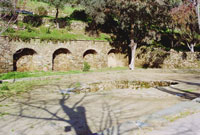 |
|
| In July 1894, the remains of an atrium with a large earthenware jar in its center was discovered. In July 1898, the water channel between the atrium and the chapel, with several jars along its route was unearthed. From 11th to 22nd of July of the same year, on the south side the right hand side facing the archways, a masonry wall with a perforate marble plaque forming a fountain, and right beside it a rustic staircase, were found. Between 23rd July and 17th of August, the 4 arches were uncovered though one of them, the second from the right, was very much damaged. Under the 3rd (and the 4th) a skeleton and the remains of a terracota sarcophugus were discovered. The head of the skeleton was turned towards the chapel, the feet towards Karacah, the hill by the gendarme post. Coins, funerary lamps and glass objects were found at the same time.
Between December 16th 1897 and 1899, various other objects were unearthed, including terraced walls from the atrium, a mould which may have been for hosts, funerary lamps, an urn containing the bones of an infant and a 10 meter long mosaic which has unfortunately since been destroyed. In 1965 the demolition of the guest house, built in 1894, revealed the large impluvium visible in the center of the atrium. |
|
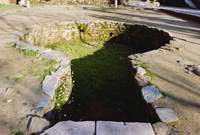 |
|
There has been some suggestion that the impluvium was a baptistery but from the 4th century baptistries built near important churches were never deeper than the height of a man and had steps going down one side and coming up the other, almost always west to east (like the baptisteries which can be seen in St. John's Basilica and in the Church of the Council of Ephesus), and since the impluvium has none of these features, this theory can be safely dismissed. |
|
| The coins found during the excavations have been examined by Professor Horace Marrucchi and he has catalogued them as follows:
No1: modern
No2: reign of Constans II (+668)
No3: reign of Justinian II (+709)
No4: reign of Anastasius I (+518)
The letter M on them is characteristic of Byzantine coins along with the inscription CON-CONC which signified Constantinople. The Greek letters gamma and epsilon represent either the year of the reign, or the value of the coin, standing for 3 and 5 respectively. This collection of the objects point to there having been a monastery there. This would also explain why this place is marked on an Ottoman land register as "The Three Doored Monastery of the All Holy". However this theory has yet to be confirmed. |
|
| THE AVENUE AND THE STATUE OF THE VIRGIN
The olive trees on both sides of the footpath which leads to Virgin Mary were planted by the Lazarist fathers in 1898. The statue greeting visitors with open arms is dated 1867. It was presented to the sanctuary by a religious community which was leaving its house in Izmir. |
|
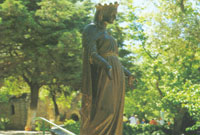 |
|
| It was erected on its present site by Fr. Francois Saulais, a Little Brother of Charles de Foucault, around 1960, when he was chaplain at Virgin Mary along with Fr. Joseph Bouis. This is the probable site, at least from 1896 to 1914, of the statue which is now in the chapel. |
|
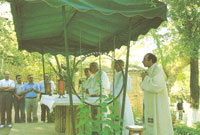 |
|
THE RAISED EARTH PLATFORM AND THE ALTAR
The earth bank beside the chapel already existed when Virgin Mary was discovered. Because of its position, it was thought ideal for open air ceremonies, so on August 14th 1965, the Montfortain Fathers, who succeeded the Little Brothers as custodians of the shrine, erected an altar there. |
|
| Today Mass is celebrated there every Sunday and visiting groups
also have their liturgies there. |
|
|
THE EXTERIOR OF THE CHAPEL
When the chapel was discovered it was in a desperate state. Although the left wall was intact, the earth banking, where the altar now stands, extended right up to the wall.
The red line which can be seen on the outside shows exactly how high the earth reached.
|
|
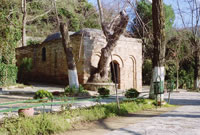 |
|
| The characteristic facade with its three doors, of which only the central one is really a door, was much as it is now apart from a little damage to the bricks in the center of the arch and the right hand corner. The right hand wall was almost intact except for the part between the facade and the first plaster, which had fallen into the vestibule. In the little chapel, only the wall where the little apse is, was intact; all the others were greatly damaged. From 1898 to 1900 the chapel was protected by a temporary roof which did not change the character of the building at all. Later during the war, between 1915 and 1923, the roof was destroyed and the general state of the building deteriorated. In 1950 with the help of Swiss and American Catholic Associations restoration was undertaken. This was solemnly inaugurated by Archbishop Descuffi, Archbishop of Izmir, on June 19th 1951. |
|
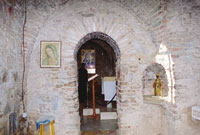 |
|
INTERIOR CHAPEL - COMMEMORATIVE PLAQUE
As you enter the vestibule, on the left at the height of the arch which opens on to the chapel itself, is a plaque
commemorating the visits of two Popes. Paul VI on July 26th 1967, John Paul II on November 30th 1979. |
|
| ENGRAVING ON COPPER
Above the arch hangs a copper engraving. The design is the idea of a Vietnamese Catholic teacher and the work itself was carried out by a Moslem artist from the Maghreb, North Africa. It illustrates Revelation chapter 12, verses 13-17. St Epiphanius wrote as a commentary on his passage in Jerusalem around 400 AD: "The Revelation of St. John says that the dragon hurled itself on the woman who had given birth to a male child and that eagle's wings were given to the woman and that she fled into the desert so that the dragon was unable to seize her. It is possible that all this was accomplished in Mary". |
|
|
STATUE
Climbing the two steps you reach the chapel. In the center of the apse, above the altar, there is a statue of the Virgin. The statue is in bronze and is a replica of the image of the Miraculous Medal. The Lazarist Fathers are, like Catherine Laboure to whom the Blessed Virgin appeared in 1830, children of S1. |
|
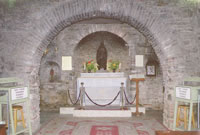 |
|
| Vincent de Paul and they felt morally obliged to place this image which is so representative of the spirit of their Institute, at Virgin Mary. Fr. Euzet who was one of the first witnesses to the discovery of Virgin Mary wrote: "The road leading to the chapel was planted with olive trees. Towards the middle of this path a rock formed a natural plinth on which a statue of the Virgin with her arms outstretched as on the Miraculous Medal was placed.
BLACK MARBLE TILE
On the floor in front of the altar is a black marble tile. This marks the place of the original fireplace, dating perhaps from the 1st century and discovered in 1898. Fr. Jung who was there, noted in the "Golden Book of Panaya" (begun in 1891): "During the work at the chapel which was to clear the floor, on August 24th at half past three, the workmen discovered some marble tiles. A continued search revealed two cubic meters of stones which were blackened by smoke and not charred". This was countersigned and witnessed by Fouquet, Gouyet and Mathinet. Fr. Poulin recorded that the stones were black on the bottom and white on the top and that there was also "coagulated" ash to which miracles which have been recognized by the diocesan authority have been attributed.
CANDLES
The burning of candles or lights in shrines is neither a specifically Christian nor a specifically Moslem custom but is common to many religions. The flame can be seen as a symbol of the presence of the believer even after that person has left the shrine.
BRONZE LAMP
To the left of the altar, in a niche which is very ancient, is the bronze lamp presented by Pope Paul VI during his visit July 26th 1967.
SMALL CHAPEL
On the right, facing the main altar, is a small chapel. Since 1891, this has been called by some, "Mary's Chamber" because it corresponds to the bedchamber in Anna Katharina Emmerich's description of the House. The "chamber" is without doubt the part of the building which has the richest history as Professor Prandi showed in the text quoted earlier.
DARKER PAVING STONE
The part of the floor in the middle which is darker marks the place where the spring was discovered in 1891. Fr. Poulin wrote: "The floor had subsided, and right in the middle of the floor was a hole in the form of a funnel about 60cm deep and about the same in diameter. A primitive hole made with a pick, no doubt to find the water which feeds the springs below and which, for some reason or another, had dried up or been lost. At the bottom of the hole we saw another, had dried up or been lost. At the bottom of the hole we saw the water well up and rise to a level that is never passed... The inhabitants of Cirkince (Sirince Village) call this water 'ayasma', holy". In the Golden Book of Panaghia is written: "Since the water is no longer sufficient, on the August 5th 1898, two men opened up a well on the left at the back of the chapel. Abundant water was found there about three meters down". This well still exists and it feeds the springs below the chapel. |
|
 |
|
SMALL PICTURE OF THE VIRGIN MARY
The fine picture of the face of Mary was done by the painter Ratislas Loukine while he was on a visit to Virgin Mary in 1978. Loukine lived at that time in Proverville, France. |
|
| THE SPRINGS
On the left as we leave the chapel at the end of the square, there is a stairway which leads to the springs where the visit to Virgin Mary ends. These are fed with drinking water from the well to the north east of the chapel. Some say they have obtained cures from drinking this water. Many visitors drink the water and like to take some away with them. |
|
| Turning our backs on the springs, we follow the path to the exit. Our visit to this place, holy for both Christians and Moslems. ends. This place, the chapel and its surroundings became. in 1892. the property of Sister Marie de Mandat Grancey, who inspired the search for Virgin Mary. The title then passed to Fr. Poulin and then to Fr. Euzet who gave it to the Dernek (Association) who manages it today, though the property has been much reduced to profit the National Forest which surrounds it. |
|
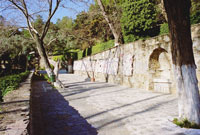 |
|
|
 |
|
|
|